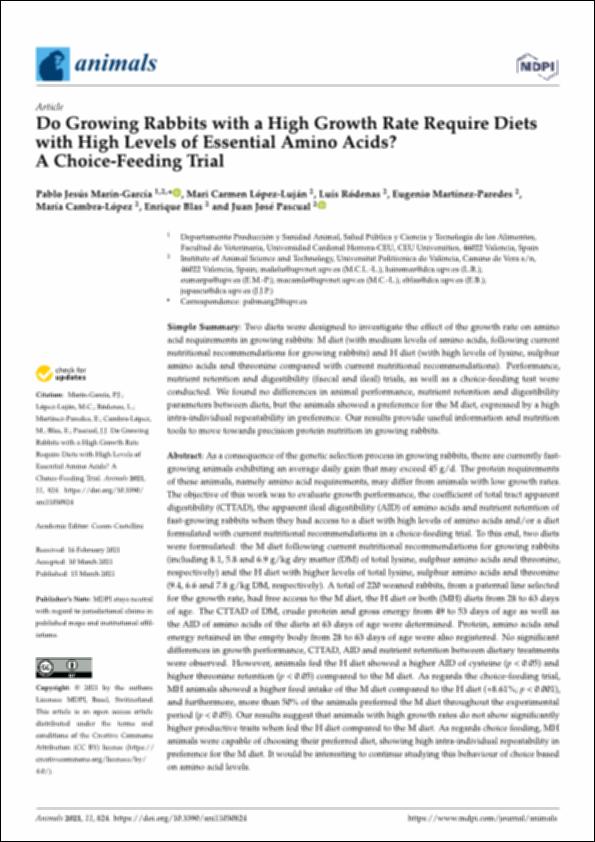Por favor, use este identificador para citar o enlazar este ítem:
http://hdl.handle.net/10637/13439Do growing rabbits with a high growth rate require diets with high levels of essential amino acids? : a choice-feeding trial
| Título : | Do growing rabbits with a high growth rate require diets with high levels of essential amino acids? : a choice-feeding trial |
| Autor : | Marín García, Pablo Jesús López Luján, Mari Carmen Ródenas Martínez, Luis Martínez Paredes, Eugenio Melchor Cambra López, María Blas Ferrer, Enrique Pascual Amorós, Juan José |
| Materias: | Rabbits - Feeding and feeds.; Amino acids in animal nutrition.; Proteínas en nutrición animal.; Conejos - Alimentación.; Aminoácidos en nutrición animal.; Proteins in animal nutrition. |
| Editorial : | MDPI |
| Citación : | Marín-García, P.J., López-Luján, M.C., Ródenas, L., Martínez-Paredes, E., Cambra-López, M., Blas, E. & Pascual, J.J. (2021). Do growing rabbits with a high growth rate require diets with high levels of essential amino acids? : a choice-feeding trial. Animals, vol. 11, i. 3 (15 mar.), art. 824. DOI: https://doi.org/10.3390/ani11030824 |
| Resumen : | As a consequence of the genetic selection process in growing rabbits, there are currently fastgrowing animals exhibiting an average daily gain that may exceed 45 g/d. The protein requirements of these animals, namely amino acid requirements, may differ from animals with low growth rates. The objective of this work was to evaluate growth performance, the coefficient of total tract apparent digestibility (CTTAD), the apparent ileal digestibility (AID) of amino acids and nutrient retention of fast-growing rabbits when they had access to a diet with high levels of amino acids and/or a diet formulated with current nutritional recommendations in a choice-feeding trial. To this end, two diets were formulated: the M diet following current nutritional recommendations for growing rabbits (including 8.1, 5.8 and 6.9 g/kg dry matter (DM) of total lysine, sulphur amino acids and threonine, respectively) and the H diet with higher levels of total lysine, sulphur amino acids and threonine (9.4, 6.6 and 7.8 g/kg DM, respectively). A total of 220 weaned rabbits, from a paternal line selected for the growth rate, had free access to the M diet, the H diet or both (MH) diets from 28 to 63 days of age. The CTTAD of DM, crude protein and gross energy from 49 to 53 days of age as well as the AID of amino acids of the diets at 63 days of age were determined. Protein, amino acids and energy retained in the empty body from 28 to 63 days of age were also registered. No significant differences in growth performance, CTTAD, AID and nutrient retention between dietary treatments were observed. However, animals fed the H diet showed a higher AID of cysteine (p < 0.05) and higher threonine retention (p < 0.05) compared to the M diet. As regards the choice-feeding trial, MH animals showed a higher feed intake of the M diet compared to the H diet (+8.61%; p < 0.001), and furthermore, more than 50% of the animals preferred the M diet throughout the experimental period (p < 0.05). Our results suggest that animals with high growth rates do not show significantly higher productive traits when fed the H diet compared to the M diet. As regards choice feeding, MH animals were capable of choosing their preferred diet, showing high intra-individual repeatability in preference for the M diet. It would be interesting to continue studying this behaviour of choice based on amino acid levels. |
| Descripción : | Este artículo se encuentra disponible en la siguiente URL: https://www.mdpi.com/2076-2615/11/3/824 Este artículo pertenece al número especial "Nutritional Strategies to Improve Feed Efficiency in Monogastric Animals towards Environmental Sustainability". |
| URI : | http://hdl.handle.net/10637/13439 |
| Derechos: | http://creativecommons.org/licenses/by/4.0/deed.es |
| ISSN : | 2076-2615 (Electrónico) |
| Fecha de publicación : | 15-mar-2021 |
| Centro : | Universidad Cardenal Herrera-CEU |
| Aparece en las colecciones: | Dpto. Producción y Sanidad Animal, Salud Pública Veterinaria y Ciencia y Tecnología de los Alimentos |
Los ítems de DSpace están protegidos por copyright, con todos los derechos reservados, a menos que se indique lo contrario.


